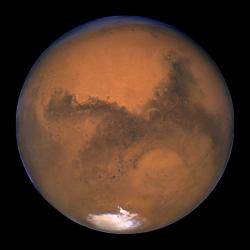Issue Date: January 16, 2004
Grace still waits in the heavens as we learn to accept our humble place in the universe By ANDREW LAM Though barely middle-aged, I am old enough to remember a time when Earth was just a lonely blue planet amid the heavens. I remember, too, that precise moment when man’s gaze turned upward, in awe. It was the winter of 1968, the worst period of the war, and I was a child living in Vietnam. But on TV, instead of the regular news about the war, three peculiar creatures danced on a barren landscape. Until that moment, I had believed what my grandmother told me: that a beautiful moon goddess resided on the silver globe that hung outside my window. But by stirring up the lunar dust with their metallic boots, the American astronauts effectively debunked the goddess’ corporeal existence. In her place is a radical shift in human psyche regarding its relationship with the rest of universe. Consider these astonishing discoveries made in the last decade:
Until quite recently, we humans have been egocentric when explaining our place in the universe. Half a millennium ago we assumed our world was the universe’s center -- and, for that matter, flat -- and that the sun orbited Earth. Last century we held on to the notion that our solar system was unique. Scientists just a generation ago assumed, too, that conditions on Earth -- a protective atmosphere, ample water and volcanic activity -- made it the only planet that could possibly support life. That sense of self-importance has given way to a more humble assessment of our place in space. The conditions on our home planet may be unique, but solar systems are not at all anomalies. We are in the process of accepting that we are very much part of larger universe. Furthermore, we are -- by sending space probes to the edge of the solar system, by collecting moon rocks and comet dust, by landing probes on Mars to dig for soils and search for signs of life, and by planning manned missions to Mars -- in constant exchange with the universe. These days many scientists dare to believe that we are not alone. Take astronomer Sergio Fajardo-Acosta, a research associate at the University of Denver. He believes many civilizations exist in the universe. “The distances are staggering and communication is a problem, especially if that civilization is in another galaxy,” Fajardo-Acosta writes. “But with imagination and a very sophisticated technology, I think we could probably overcome the distance limitation and communicate with others.” Nietszche asked rhetorically, “Have you not heard that God is dead?” Galileo, Newton, Einstein and the like had revealed a universe more startling than any ancient myth could describe. But it is my contention that science, even as it slays the old gods, does not destroy human spirituality. Quite the contrary: In the cosmic age, science and spirituality reinforce each other. Science chips away at our ancient myths, only to reveal even greater mysteries. The more science reveals, the more mysterious and sublime the revelation. With two NASA spacecraft missions to Mars in search of signs of life this January, space exploration should fill us all with a renewed sense of wonder. The sea on which humanity now sails is infinitely more vast and wondrous than that imagined by Columbus. And though wars and famines and diseases still grip mankind, when we look upward, it seems that there’s ample grace waiting in the heavens. Andrew Lam is a journalist and short story writer. National Catholic Reporter, January 16, 2004 |

